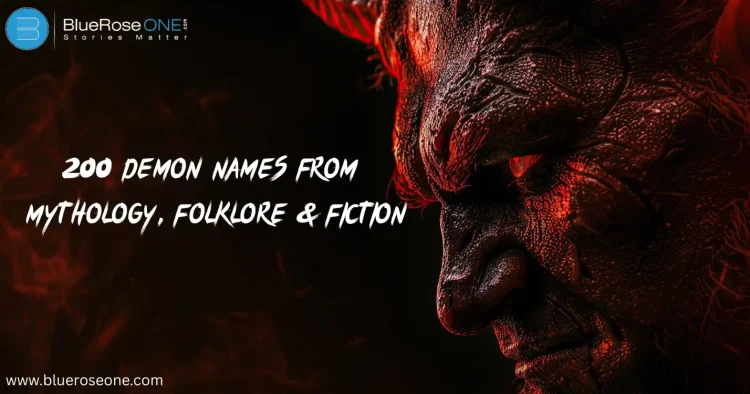Ever wondered what lurks behind the veil of myths, scriptures, or horror movies? Demon names have always stirred fascination, fear, and creativity. From ancient scrolls to modern RPGs, these names pop up everywhere. Whether you’re writing fiction, researching folklore, or just curious, this massive A-Z list of 200 demon names will quench your thirst for the arcane.
Table of Content
What Are Demon Names and Why Do They Matter?
Origins in Mythology and Folklore
Demon names aren’t just random gibberish from horror tales. Many come from ancient religious texts, pagan traditions, and local legends. Some were once gods, later demonized by rival faiths.
For instance:
- Asmodeus comes from Persian lore, featured in the Book of Tobit.
- Baal was a god to the Canaanites, labeled as a demon in Christianity.
Influence in Modern Fiction and Pop Culture
From “The Exorcist” to “Supernatural”, demon names are a staple in fantasy and horror genres. They add mystery, danger, and power to stories. Ever played a game and summoned Paimon or fought Lilith? That’s the power of names.
A-Z Demon Names List
Let’s take a deep dive into the 200 most intriguing, terrifying, and iconic demon names you’ll ever encounter. Buckle up—this is your infernal dictionary!
You may also like: Best Stephen King Novels for First-Time Readers
A-D Demon Names
- Aamon – Goetic demon; Marquis of Hell.
- Abaddon – Angel of the abyss in Hebrew texts.
- Asmodeus – Lust demon; major figure in demonology.
- Andras – Wreaks discord; rides a wolf with a sword.
- Baal – Once a storm god; now Prince of Hell.
- Baphomet – Symbol of the occult; goat-headed idol.
- Beelzebub – Lord of the Flies, second only to Satan.
- Belial – Wickedness personified; King of Evil.
- Caim – Appears as a thrush; teaches languages.
- Chort – Slavic demon; half-man, half-goat.
- Charun – Etruscan underworld demon.
- Dantalion – Knows all human thoughts.
- Decarabia – Shape-shifting demon of herbs and gems.
- Drekavac – Serbian ghostly child demon.
You may also read: Top Cozy Fantasy Books Every Bookworm Will Love
E-H Demon Names
- Ereshkigal – Sumerian goddess of the underworld.
- Eurynome – Greek female demon who eats flesh.
- Eligos – Goetic demon; knows war and future.
- Furfur – Speaks only lies unless compelled in triangle.
- Flauros – Reveals secrets and protects magicians.
- Foras – Teaches logic and ethics.
- Gusion – Answers all questions truthfully.
- Gaap – Controls love and hatred.
- Gremory – Appears as a woman; love and divination.
- Hecate – Greek goddess of witchcraft, often linked with demons.
- Hinn – Arabian folklore; shape-shifting demon.
- Halphas – Commander of demonic armies.
I-L Demon Names
- Incubus – Male demon who seduces women in sleep.
- Iblis – Islamic version of Satan.
- Ifrit – Fire spirits from Arabic lore.
- Jezebeth – Demon of falsehoods.
- Jikininki – Japanese corpse-eating spirit.
- Kali – Hindu goddess of destruction (demonized in some Western views).
- Kimaris – Rides a black horse; teaches grammar.
- Kobal – Demon of comedy and mockery.
- Lilith – Adam’s first wife turned night demon.
- Leviathan – Giant sea serpent, chaos incarnate.
- Lucifuge – Avoids light; high demon in Grimoires.
You may also like: Best Stephen King Novels for First-Time Readers
M-P Demon Names
- Mammon – Personification of greed.
- Malphas – Constructs fortresses; deceiver.
- Moloch – Demands child sacrifice.
- Naberius – Barks like a dog; persuasive speaker.
- Nybbas – Demon of dreams and visions.
- Orobas – Tells the future and protects from lies.
- Oriax – Knows astronomy and liberal sciences.
- Pazuzu – Babylonian wind demon; protects from other demons.
- Phenex – Beautiful poet; sings sweet melodies.
- Paimon – Popular in movies; obedient and wise.
Q-T Demon Names
- Raum – Steals treasure; destroys dignity.
- Ronove – Teacher of languages.
- Ravana – Demon king in Hindu epic, Ramayana.
- Samael – Angel of death, also seen as demon.
- Stolas – Owl demon of astronomy.
- Sitri – Incites love and lust.
- Thamuz – Assyrian god turned demon.
- Tannin – Sea monster from Canaanite lore.
- Tzitzimime – Aztec star demons; skeletal and violent.
U-Z Demon Names
- Ukobach – Glows with fire; keeps Hell’s oil burning.
- Uvall – Appears as a camel; reveals secrets.
- Valefar – Steals treasures; friendly but deceitful.
- Vine – Commands storms and reveals secrets.
- Vassago – Finds lost things and tells the future.
- Xaphan – Fan of flames; rebelled with Lucifer.
- Xolotl – Aztec god-demon, twin of Quetzalcoatl.
- Yekun – Rebel angel; seduced other angels.
- Yama – Hindu and Buddhist god of death, demonized in some lore.
- Zepar – Makes women fall in love.
- Ziminiar – One of four principal kings of Hell.
You may also like: The Housemaid Series in Order: A Complete Reading Guide
Demon Classifications: Types & Roles
Princes of Hell
In demonology, the Princes of Hell are powerful rulers who preside over vast legions of demons and hold high-ranking positions in Hell’s hierarchy.
Often seen as counterparts to archangels, these infernal princes such as Lucifer, Beelzebub, and Asmodeus embody deadly sins and command immense influence. Each prince is associated with specific domains like lust, pride, or wrath, and their names frequently appear in grimoires and occult texts. They represent the elite class in demonic classifications.
Goetic Demons
Goetic demons are mentioned in Ars Goetia, the first section of The Lesser Key of Solomon, a 17th-century grimoire. This literature describes 72 demons, each with their own titles, powers, and hierarchies, who frequently rule legions of souls. Summoners believed that by using ritual magic, these creatures could be forced to serve.
Goetic demons are commonly referred to as kings, dukes, presidents, and other titles, indicating their hierarchical infernal order and specific functions, such as exposing secrets, imparting wisdom, or controlling emotions.
Elemental and Nature Demons
Elemental and nature demons are spirits tied to the raw forces of the natural world earth, fire, water, and air. These entities often appear in mythologies as powerful beings capable of controlling storms, shaping terrain, or causing natural disasters.
In folklore, they may guard sacred groves or curse those who exploit nature. Unlike purely evil demons, many elemental spirits are neutral or chaotic, acting in accordance with natural balance rather than human morality.
You may also like: 150 Useful Tone Words to Describe Tone | Explanation with Examples
Should You Use Demon Names?
Ethical Consideration
Before using demon names in writing or rituals, it’s important to reflect on the ethical implications. Some cultures view these names as sacred, dangerous, or disrespectful to invoke lightly. Writers should be mindful of cultural appropriation and avoid sensationalizing beliefs they don’t fully understand.
Using demon names for entertainment, especially from living traditions, can offend followers and perpetuate harmful stereotypes. Ethical storytelling means respecting the origins, meanings, and impact these names carry across different societies.
Creative Inspiration vs. Spiritual Risk
In books like The Lesser Key of Solomon, demon names are often used to invoke mystery, power, or forbidden knowledge—fueling creativity for authors and artists alike. However, using such names can blur the line between imaginative expression and spiritual risk.
Some believe invoking these names, even fictionally, may invite negative energy or unintended consequences. While the allure of the occult is creatively rich, it’s important to approach it with awareness, respect, and clear artistic intention.
Conclusion
There you have it, a deep, fiery dive into 200 demon names from around the world. From ancient rituals to Hollywood scripts, these names echo with mystery and power. Use them to inspire, intrigue, or terrify but always with respect for the lore they come from.
















